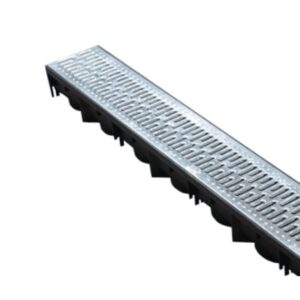Garden Drainage Solutions
Regardless of whether you're an avid gardener or not, a waterlogged garden is a major concern for every homeowner. This happens when rainwater has nowhere to drain off and remains trapped in the soil. While some simpler solutions like aerating the soil, planting more vegetation, or using raised beds with topsoil might resolve the issue, many people prefer not to compromise on their garden's aesthetic appeal. For severe cases, a more complex drainage system is often necessary to address the problem effectively.
Signs such as sunken grass or large puddles in your garden are clear indicators of poor drainage. A simple test involves digging a hole and filling it with water—if it doesn't drain within a few hours, you likely have drainage issues. You might also notice soggy grass underfoot, which is far from ideal. In extreme situations, the soil becomes so saturated that grass won't grow at all. If you're dealing with this scenario, keep reading to learn about various drainage systems that can help improve your garden.
Types of Drainage System
Drainage systems are particularly beneficial for gardens located at the bottom of hills or valleys, where they often act as the final destination for runoff from surrounding areas. Frozen ground or slow-draining clay soil only exacerbates the problem.
At its core, poor drainage results from water collecting faster than it can drain away. Therefore, drainage systems typically consist of two main components: something to collect the water and something to either store or dispose of it. Let’s explore some of the options available if you need a fairly intensive drainage solution.
French Ditch System
This system involves creating a sloped trench filled with aggregate that redirects stagnant water from garden surfaces toward storm drains. It’s a great option for flood-prone areas and must be installed at the lowest point in your garden.
Modern French drains incorporate perforated pipes and non-woven geotextile membranes, making maintenance easier while preventing debris from entering the drain through the water flow. Potential endpoints for French drains include soakaways, gutters, or gravel pits.
A French Drain generally involves digging a trench through flooded areas, lining it with non-woven geotextile membrane, adding a base of pea shingle (10mm/20mm), laying a half-perforated pipe on top (with perforations facing upwards), covering the pipe with more pea shingle until it’s fully encased, wrapping the entire assembly in geotextile membrane, and finally refilling the trench. This setup allows water to drain into the pipe and be carried away from the area.
Herringbone Drainage
Based on the same principles as the French Drain, a Herringbone Drain (also known as a Christmas Tree Drain) is essentially the layout of the pipes. It consists of a main drain with smaller “arms†or “branches†connecting into the central drain. This configuration collects water from a large area and moves it away. It’s especially useful for large lawns.
Simple Ditches
This is the simplest and most cost-effective drainage option, commonly seen in driveways. Essentially, you dig a trench about 90cm deep with sloped sides supported by large stones, add a layer of small stones at the bottom, and ensure the water flows out. You can even transform this into a decorative creek by adding plants. However, for bigger or more waterlogged lawns, larger-scale French and Herringbone systems might be more appropriate.
Soakaway Crate Systems
Soakaway crate systems are arguably the most effective way to eliminate standing water in a garden. You can purchase 1m³ soakaway crate kits, which are ideal for most residential projects. While this is one of the pricier solutions, it’s also highly efficient. These crates can hold vast amounts of water underground, allowing it to dissipate slowly into the soil rather than flooding your garden.
Stack Drain
This innovative solution works well for patio drainage or standing water on hard surfaces. Simply dig a small hole and insert the stack drain. Water enters the stack drain and drains away similarly to a soakaway system.
Channel Drainage
Sometimes, the best approach isn’t to implement a garden drainage system but to stop water from reaching the garden altogether. A channel drainage system collects water and transports it to the underground drainage system before it reaches the garden.
No matter which method you choose, consult a professional for advice and ensure your drainage solution complies with local regulations—avoid fines and the hassle of undoing all your hard work!
Drainage Plank
Drainage planks are a new drainage product designed for drainage, ground stabilization, and even filtering out silt and dirt from water. They’re excellent for gardens because they’re easy to install and simply need to be placed in the ground. They never clog with silt or dirt and work similarly to French drains by carrying water away. They’re often installed in a herringbone pattern to remove surface water and discharge it elsewhere.
Common Drainage Problems
Let’s now focus on specific problems caused by poor garden drainage and how to solve them.
Uneven Patio Surface
An uneven patio can direct water in the wrong direction, resulting in small puddles forming between and along the edges of tiles. The best solution is to remove all the slabs and start again—otherwise, consider the stack drain system for a quick fix.
A Leaky Pool or Fountain
This might sound obvious, but any improperly installed water feature or one with a leak can significantly contribute to your garden becoming waterlogged. It can even overflow into your neighbor’s garden—no one wants that affecting their social life!
In this case, examine any design features that could be causing leaks and seek professional assistance to fix them.
A Leaking Water Main
Sometimes, the issue isn’t drainage at all but a leaking water main beneath the soil. Did you know that 3,113 million liters of water leaks from water mains daily in the UK? That’s equivalent to 1,245 Olympic-sized swimming pools!
Clay Soil
Clay soil is problematic in rainy UK gardens, as it doesn’t drain water nearly as well as other types of soil. You’ll need to install a drainage system that draws water away from the soil in this situation—just don’t use a soakaway system, as it will likely get blocked. Instead, divert the water toward a nearby sewer using sewer pipes or into a watercourse (check with your local council first to see what’s allowed in your area).
Incorrectly Installed Guttering
It’s surprisingly common for poorly installed downspouts to dump water directly onto the lawn without homeowners realizing. Improperly installed guttering can also lead to issues during heavy rainfall, where water spills directly onto the garden.
To solve this, consider investing in a downspout to drain connector to ensure surface water only goes to the drain. Additionally, look into a rainwater harvesting system—not only will it protect your yard, but it could save you money on water bills in the long run. You can even use the harvested water to irrigate your garden in a more controlled manner.
Typically, the trap should be placed on a precast concrete slab, bricks, or in-situ concrete, with the grid adjusted to the appropriate ground level to connect the rainwater downpipe or waste pipe. Then, connect the drainage pipe to the main drainage run or soakaway crate system.
Author Bio
Nathan Wilde

Nathan has spent over 12 years in the drainage and plastics industry. Having worked for both builders’ merchants and major manufacturers, he’s gained extensive industry and product knowledge. At EasyMerchant, Nathan is dedicated to making tradespeople’s lives easier.
Shop Garden Drainage Products

Galvanised Drainage Channel x1m
Door Handle On Rosette,Brushed Lever Door Handle,Front Lever Door Handle,Fancy Solid Lever Door Handle
Wenzhou Shenghong Metal Products Co.,Ltd , https://www.shenghonglock.com
